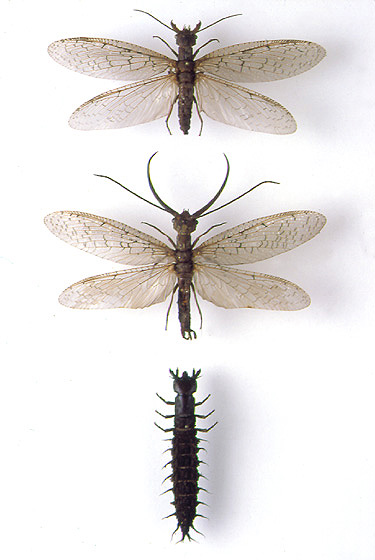Eastern Dobsonfly (Corydalus cornutus)
Pricing: Dead (spread, as pictured): $20-$40 (female): $40-$60 (male), depending on size and quality.
Geographic Range: Eastern North America
View: Top View Sex: Female (top) & Male (bottom)
Size: Wingspan: 12 cm / Length: 9 cm (larvae)
Eastern Dobsonflies are unusual-looking insects found in close association with fast-flowing, well-oxygenated streams. The adults can be found at rest on logs, rocks and vegetation near these watercourses. Eggs are laid in large clumps on objects at the water's edge. The larvae are fully aquatic, usually found amidst stones and boulders in the heart of the current. These larvae are called hellgrammites and are often used as bait by fisherman. They have 8 pairs of abdominal filaments and 7 pairs of gill tufts, which are located at the base of the first seven filaments. After 2-3 growing seasons they emerge from the water and pupate in earthen cells beneath rocks or logs. Corydalus cornutus is widespread east of the Rocky Mountains and is actually one of the largest insects found in North America, with adults having wingspans up to 12 cm. In addition, the males are armed with long, tusk-like mandibles up to 4 cm in length, giving them a ferocious appearance. Although these mandibles end in sharp points and the muscles within the head allow the males to give a good pinch, they are actually rather fragile structures. In order to make the animal lighter and allow it greater ease in flight, the mandibles are not solid within and can be easily broken. Females are not armed with these fearsome-looking weapons but can still give a nice little nip to a careless finger with their own short mandibles. The larvae have mandibles almost identical to those of the female. While the adults do not eat and use their mandibles for defense only, the larvae are active predators that hunt for other insects on the bottom of the stream. Corydalus cornutus has at various times been described as a "new" species so it is also known by the synonyms C. crassicornis and C. inamabilis. It should be noted that three additional species of Corydalus can be found in the U.S.A. - all very similar in appearance to C. cornutus. The most widespread is Corydalus texana (=cognata), known as the Western Dobsonfly. It can be found throughout the southwestern portion of the U.S.A. west of the Rocky Mountains. The two other species are much more limited in distribution; Corydalus bidenticulatus (=lutea) - a chiefly Mexican species - is confined to Arizona and Corydalus luteus - a chiefly Central American species - is confined to southern Texas. These species can be distinguished from C. cornutus by their limited distribution. Adult dobsonflies can fly well and are sometimes attracted to lights.

